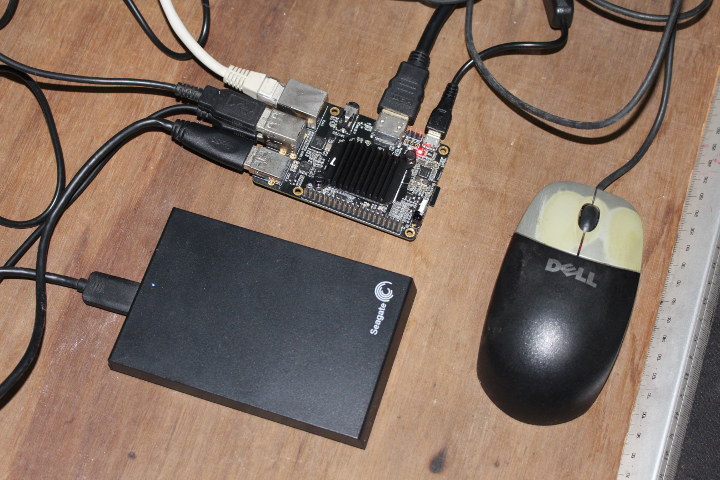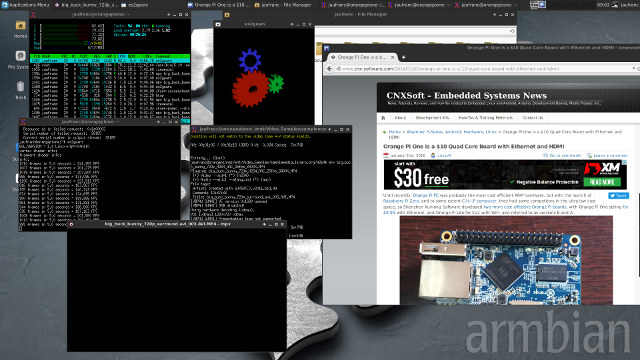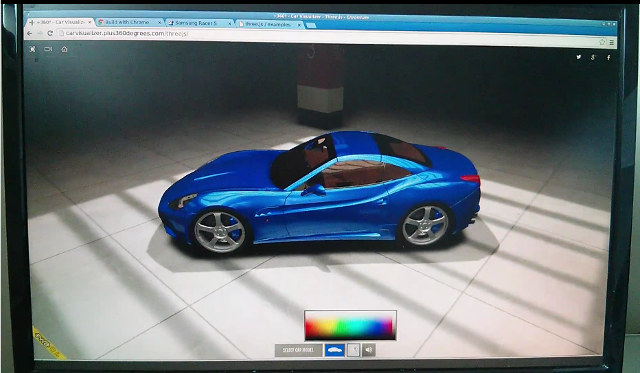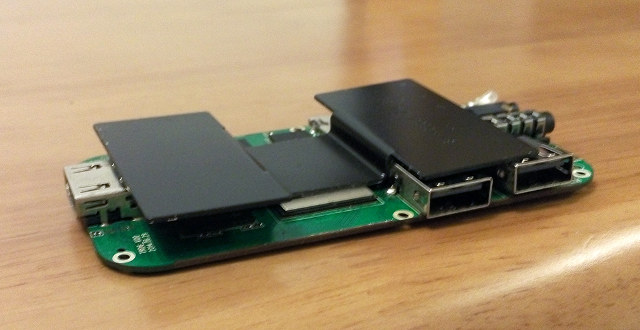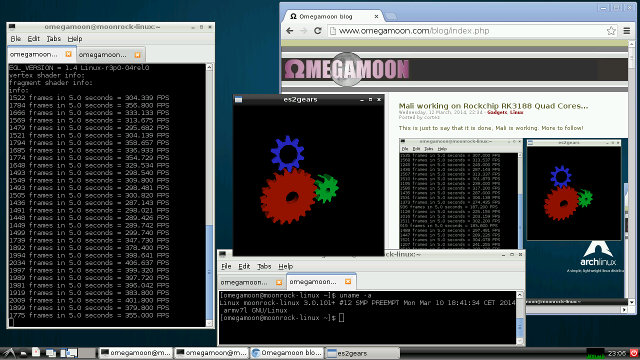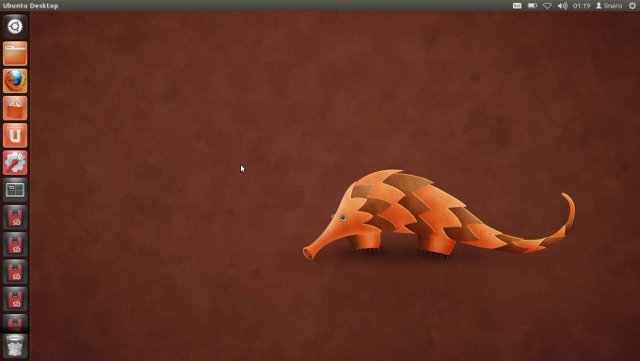Firefly team from T-chip company has send me some of their Rockchip development boards, and we’ve already checked the provided boards and accessories, so today I’ll report my experience with one of the board: ROC-RK3328-CC also known as Renegade. I won’t test it with Android, since I have already reviewed RK3328 Android TV boxes such as Zidoo X7, and I’ve been told the team is hard at work with Android 8.1 SDK, so an Oreo image should be released in a few weeks/months. So I had initially planned to report my experience with one of the Linux images, then show how to install mainline Linux (currently 4.17) to the board, and reports what works. However, I encountered many issues, although likely not directly related to the board or its software support, so instead I’ll write about my experience getting started with the board, and list all the issues I had […]
Accelerated 3D Graphics, Hardware Video Decoding, and Network Performance on Orange Pi One Board (Video)
I’ve just written Getting Started Guide for Orange Pi One, a $10 development board based on Allwinner H3 quad core Cortex A7 processor, where I explain how to install and configure Armbian distribution on the board. As promised, I’ve also tested 3D graphics acceleration, and hardware video decoding, and also included some Ethernet benchmarks. Since ARM Mali-400 GPU found in Allwinner H3 is only capable of OpenGL ES, as in most ARM SoCs, you can test 3D graphics acceleration by using es2gears (and not glxgears as I’ve seen some other do in the past):
|
1 2 3 4 5 6 |
es2gears EGL_VERSION = 1.4 Linux-r3p0-04rel0 vertex shader info: fragment shader info: info: 1463 frames in 5.0 seconds = 292.425 FPS |
The log shows the utility is using Linux-r3p0 Mali driver, and the gears are display at a high frame rate close to 300 fps. If I switch to full screen, the frame rate drops to about 43 fps, which should still be acceptable. CedarX is the infamous closed source and GPL violating media library released […]
Linux 3D GPU Acceleration Demo on Rockchip RK3288 based Firefly Board
Several devices and development boards based on Rockchip RK3288 processor already support Linux, usually with images based on Ubuntu, including Ugoos UM3 / UT3, Open Hour Chameleon, and Firefly-RK3288 among others. What these images lack however, is support for 2D and 3D graphics acceleration with the GPU, and hardware video decoding/encoding with the VPU. But Jas-hacks has made some progress with 3D graphics support. He has managed to add GPU acceleration via EGL/OpenGL ES bringing 3D acceleration to the platform, but 2D support is not there yet, meaning X11 still heavily relies on software rendering. But the implementation is still good enough to run the usual es2gears and glmark2-es2 benchmarks. as well as some WebGL demos in Chromium. Performance is currently underwhelming, with 50 points in glmark-es2, even a bit lower than the score (54 points) I got with ODROID-X board powered by Exynos 4412 SoC with a Mali-400MP4 GPU, […]
Android 4.4 and Ubuntu 14.10 Tested on Ugoos UM3 mini PC (Rockchip RK3288)
A few days ago I posted pictures of Ugoos UM3, a cute mini PC powered by Rockchip RK3288 quad core Cortex A17 processor, with 2GB RAM, 8GB internal storage, a few USB ports, and Wi-Fi 802.11 b/g/n/ac connectivity. There are so many Rockchip RK3288 based TV boxes and sticks on the market, that it has become difficult to differentiate, so Ugoos has decided to support not only Android 4.4 like all their competitors, but also Ubuntu 14.10, and they’ve provided an alpha release of dual boot Android / Ubuntu images for Ugoos UT3 and UM3 models. Yesterday, I flashed the latest Android/Ubuntu firmware for UM3, and tested the image, so today I can report my findings. First of all, I’d like to point out that I received an earlier sample with various flaws that I reported to Ugoos, and they’ve already committed to fixes: 5V/2A power adapter is not powerful […]
Mali-400 GPU Is Now Working in Linux for Rockchip RK3188 Devices
Accelerated 3D graphics in Linux with Mali-400 via OpenGL ES has been possible for nearly a year on RK3066 devices, but there was no such support for RK3188. This week however, both Naoki FUKAUMI and omegamoon have reported OpenGL ES to work in in their respective RK3188 devices. I don’t know which device omegamoon used, but Naoki did so in Radxa Rock, and even posted instructions to build it yourself. They’ve mostly followed the work done by olegk0 for Rockchip, and Mali drivers build instructions provided in linux-sunxi community, and it can be summarize in 3 main steps: Cross-compile drm.ko, mali_drm.ko, ump.ko, mali.ko in a Linux machine Copy and load the four modules to your RK3188 based board or device. Install dependencies and binary Mali drivers from sunxi-linux in your Rockchip device Once this is done you can try some OpenGL ES demos such as esgears2 or glmark2-es to test […]
Ubuntu Linaro 12.11 with 2D/3D Mali-400 GPU Acceleration on ODROID-X Development Board
A few days ago, Hardkernel released the first version of Ubuntu 12.11 (Linaro) with Mali-400 GPU support for their ODROID boards (ODROID-X/X2, ODROID-U/U2). This is still WIP (Work in Progress), but this is one of the few boards together with Pandaboard, Origen and Snowball that can support 2D/3D GPU acceleration in Ubuntu Quantal. Since I have an ODROID-X development board, I decided to give it a try. There are different ways to install it. I chose the way that is most convenient for me (LCD display instead of HDMI), and likely to yield more performance (eMMC instead of SD Card). The current installation instructions to eMMC are extremely cumbersome and you have to go through 5 main steps: Install Android (yes, seriously) in the eMMC Install Ubuntu in the SD Card Install Ubuntu to the eMMC Upgrade Ubuntu to the latest version Install the Mali drivers In this post I’m […]


